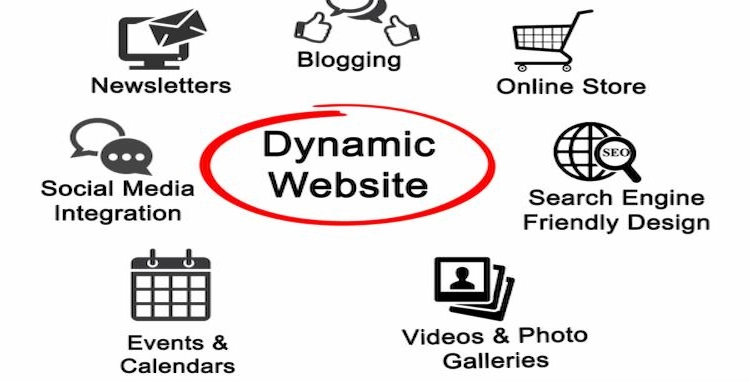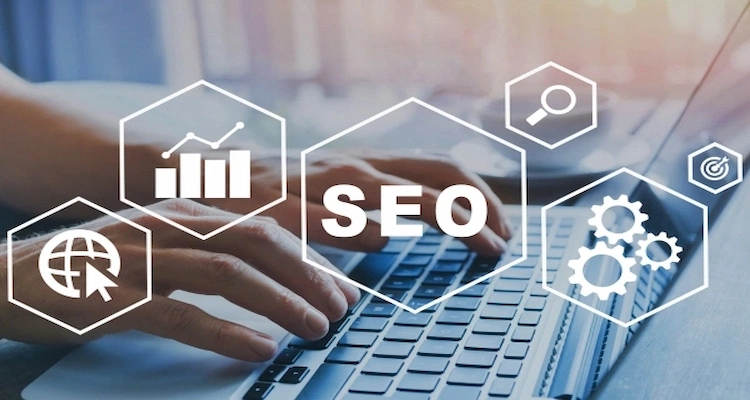For a constantly evolving digital landscape, innovation and adaptation in SEO web design are crucial.
Technology continues to advance, and businesses are rethinking their strategies to keep up. They also want to maximize their online visibility.
This blog post looks at the main SEO web design trends. It offers valuable insights to help you future-proof your website and thrive online.

SEO and Web Design
Despite the constant evolution, and arrival of new digital fads, Google’s core principle has remained unchanged. It favors websites with great user experiences (UX) design.
Why Do Some Websites Rank Higher in Search Results?
The secret lies in a powerful partnership between website content optimization and web design. Let’s look at how they work together to create a website that thrives online.
Picture a website that’s not just visually appealing but also easy to navigate. This is where web design shines. It focuses on elements like website architecture, page speed, and mobile friendliness. All of the above are are crucial for a seamless user experience.
But here’s the secret sauce: SEO based web development. It optimizes websites with relevant keywords, makes it a favorite of search engines and boosting your ranking.
But a visually appealing mobile-friendly website design is not enough. Here’s where SEO steps up. SEO involves optimizing your website with targeted keywords. You also need to ensure it’s informative, engaging, and trustworthy.
Search engines like Google value sites that provide users with valuable information. Think “Expertise, Experience, Authoritativeness, and Trustworthiness,” or E-E-A-T. E-E-A-T helps attract both potential customers and search engines.

In a nutshell, user-centric SEO web design strategies is about:
- Technical excellence: A website that functions on all devices.
- Compelling content: Content that educates, entertains, and keeps users returning for more.
- Positive user experience: A website that’s easy to navigate and fun to interact with.
- By focusing on these aspects, you’re not just creating a website. You’re crafting a digital presence that’s both visually stunning and highly visible in search results.
- To improve an existing website and keep users engaged. Consider optimizing content with schema markup for better crawling and indexing by search engines.
- Having a user-friendly mobile version is a good idea. The mobile-first index prioritizes mobile versions for crawling and indexing. It strengthens your online presence. Analyze user behavior with Google Analytics to further optimize content for mobile SEO.
- And most importantly, don’t underestimate the power of content marketing! Regularly creating valuable content can significantly improve your website’s ranking and keep users engaged.
The outcome? A surge in website traffic, enhanced brand awareness, and a plethora of new business opportunities. Remember, the key to online success lies in the powerful partnership of SEO and web design.
Less is More: Minimalism
Minimalist web page design has clean lines, lots of white space, and focuses on essentials. It saw a resurgence in 2023. This approach prioritizes creating SEO-friendly website content and ease of use, ensuring users can find information quickly. Minimalist designs minimize distractions and clutter, creating an attractive, SEO-friendly environment that keeps visitors engaged.
Think of a room with too much furniture—it’s overwhelming and difficult to navigate. A minimalist website is like a tidy room. Everything has its place, and it’s easy to find what you want. This focus on clarity is good for mobile devices, which have limited screen space.
The minimalist design prioritizes key info and user experience. It fosters a positive user journey and can improve your search ranking.

SEO for Websites: Accessibility is the New Ranking Factor
The importance of accessibility became a focal point . Inclusive design practices ensure that websites are usable to everyone, regardless of their abilities. This involves features such as alt text for images and captions for videos.
It also focused on mobile friendliness, including keyboard navigation options and compatibility with screen readers.
By using inclusive design principles:
- You cater to more people,
- Show a commitment to user experience
- Improve your search ranking.
Imagine a world where everyone has equal access to information. Inclusive design practices translate that idea into reality.
By adding features for users with disabilities, you open your website to more people. You also show social responsibility. This boosts brand reputation, and pleases search engines that value user-centricity.

Animation Infuses Websites with Dynamism
Website animation adds interactivity. It can improve user experience. In 2023, we saw an increase in the use of subtle animations. These include micro-interactions for product reveals and page transitions.
Employing more elaborate full-screen animations create a captivating storytelling experience. Strategic animation keeps users engaged on your website. This reduces bounce rates and may please search engines.
Imagine a website where product images come alive with gentle animations when you hover over them. Or, a website that uses captivating animation to tell your brand’s story. Animation can bring life to your website, making it more engaging and memorable for visitors. This can lead to more user engagement, longer dwell times, and better search ranking.

Artificial Intelligence (AI)
AI’s influence is growing on many industries, and web design was no exception. AI-powered tools began analyzing user behavior patterns, allowing for personalized website experiences. These insights can optimize website layouts, personalize content recommendations, and improve user journeys. Also, AI chatbots have become better at handling routine customer queries, freeing up business resources.
Imagine a website that anticipates your needs before you even know them. AI can analyze how users behave. It uses this to personalize content suggestions, product recommendations, and the website’s layout.
This hyper-personalized experience keeps users engaged for longer and could improve conversion rates. Also, AI chatbots can handle simple customer inquiries, freeing humans to focus on complex tasks.
3D: Adding Depth and Dimension
The use of 3D elements in website design saw a revival in 2023. 3D graphics and transitions add depth and realism to websites.
They allow for captivating visuals and interactive elements. When used well, 3D design can show users what to do and enhance brand storytelling. It may boost engagement and SEO.
Have you come across a website where you can explore a product in 360 degrees? Or, a website that uses 3D animation to show the features of a new service?
The 3D design adds interactivity and realism. It grabs user attention and creates an immersive brand experience. This can lead to more user engagement, improved brand recall, and higher search rankings.

Gamification for User Engagement
Websites use gamification techniques, including progress bars and reward systems. These elements can encourage the behavior we want.
For example, completing contact forms or subscribing to newsletters. Adding game elements increases user engagement. It may lead to more return visits, a plus for SEO.
Imagine a website. It rewards users with points or badges. They get them for tasks like reading blog posts or watching explainer videos.
Gamification can transform mundane website interactions into a fun and engaging experience. This increases user engagement. It encourages them to return for more. Keeping users engaged for longer can raise your search engine ranking.
Typography: Making a Statement
Minimalism is king for many web designers. There are others who opt for a bolder approach. Websites have vibrant colors and unusual combinations. They create striking designs that demand attention.
Similarly, we used unique fonts, sizes, and styles to experiment with visual storytelling. They created eye-catching experiences. But ensuring these bold designs resonate with your target audience is crucial. They must fit your brand identity to avoid harming your SEO.
Imagine a website that breaks the mold. It has a bold, contrasting color scheme. The scheme reflects the brand’s youthful energy. Or a website that uses a unique, hand-drawn font to convey a sense of creativity and craftsmanship.
Bold design choices can make your website stand out. They can leave a lasting impression on visitors. However, it’s essential to strike a balance.
Crazy design elements can alienate your audience. They can also hurt website functionality and SEO.
The Power of Content Boxes
Content boxes have emerged as a valuable tool for organizing website information. They allow for breaking down complex info. It makes it smaller and easier to understand. This enhances user comprehension.
Content boxes also aid SEO. They do this by working well on small mobile screens and speeding up smartphone websites.
Imagine a website that uses boxes to highlight key product features and break down complex legal jargon. Content boxes make information easier to understand and navigate, improving the user experience. Also, they are mobile-friendly, ensuring a smooth experience for visitors on phones and tablets. This is crucial for SEO in today’s mobile-first world.

Looking Ahead: How to Improve SEO with Web Design
Trends offer great insights. But remember, SEO web design is about giving the best user experience. The core principles that shape how search engines evaluate websites have stayed the same. Google continues to prioritize websites that deliver exceptional value to users.
This principle clarifies why AI-powered personalization and virtual reality immerse users in your brand’s world. Also, SEO web design will rely on content.
The optimized content must inform, entertain, or inspire. Also, best practices for mobile SEO web design ensures a user-friendly experience.
Here’s a glimpse into what you can expect in 2024 and beyond:
AI-Powered Website Personalization:
Imagine a website that meets your needs before you know them. AI will keep evolving. It will let websites personalize content, product recommendations, and user journeys based on each user’s behavior and preferences. This ultra-personalized experience will keep users engaged for longer and might also improve conversion rates.
VR Experiences in Web Design:
VR is about to leave gaming and will soon affect web design. Businesses can use VR to create immersive experiences that let users explore products, tour facilities, or attend events. This new approach could revolutionize brand storytelling and engagement, make for a more memorable user experience, and boost SEO.
Accessible Web Design Practices:
Accessibility continues to gain momentum. The focus on inclusive design will only increase in the coming years.
Accessibility is now an expectation, not a nicety. Websites will have features for users with a wider range of abilities. This ensures everyone has a fair chance to access information and engage with your brand.
Content is king:
It’s high-quality and informative. It will remain a cornerstone of SEO in 2024 and beyond. Search engines prioritize websites that offer valuable content that addresses user search intent.
Create content that educates, entertains, or inspires your target audience. This will establish you as a thought leader and a trusted resource. It will attract high-quality website traffic and improve your search ranking.
Voice Search Optimization for Websites:
The popularity of voice assistants like Siri and Alexa growing by leaps and bounds. Optimizing your website for voice search is gaining momentum. This involves using natural language in your content and making sure your website is mobile-friendly. Smartphone users conduct most voice searches.
Conclusion
SEO web design stresses a user-focused approach. It valued clear navigation, fast loading, and accessibility. Minimalism and bold design choices emerged. Innovations like AI-powered personalization and 3D elements joined them.
As we move into 2024, we expect VR storytelling to grow. There will also be a focus on accessibility and high-quality content in SEO web design.
Remember, user experience is king. Create a website that puts people first, not search engines. This will set you up for success in the changing digital world.
Tags



